Book Review: "Strip Tees: A Memoir of Millennial Los Angeles" by Kate Flannery
Deconstructing the American (Apparel) Dream
This week, I read Strip Tees: A Memoir of Millennial Los Angeles by Kate Flannery.
Once a teen gripped by the tail end of the American Apparel craze (2011-2015), I was immediately drawn to this inside look at the foundation of an indie fashion empire that dominated my youth. Though at one point in time, I may have requested to be buried in my American Apparel denim circle skirt, after all these years, I hadn’t realized I’d been hungry for an exposé on this controversial, but formerly beloved brand. I, among countless other young women who were ruled by Tumblr aesthetics and abused the “Valencia” Instagram filter, downed the AA Kool-Aid, blissfully unaware of the mess behind the scenes. Doomed to a reputation of being “cute,” I desired nothing more than to be sexy, like the girls on the billboards over Sunset. But I was still an awkward 15 year-old, debuting a big, cheesy freshly brace-less smile and struggling to be comfortable with my curve-less body. In my half-formed mind, a pair of denim hot shorts and a pastel yellow cropped baby tee was the key to instant sex appeal, and I had to have it.
I recall my mother bemoaning my fixation with the brand at the sight of the billboards. A barely clothed, barely legal girl spread eagle to be ogled by every male passerby in sight was not exactly what she had hoped her baby girl would aspire to. “As long as you keep your grades up,” she’d sigh while rolling her eyes at my dangerously short hemlines. I got “dress coded” at school several times, always by the conservative women teachers of course; it was the only time I ever got in trouble. Ever the lawyer-to-be, I would defend myself vehemently: “It’s the same length as hers!” I’d say, pointing at the cheerleader in uniform next to me. “It’s just not school sanctioned! This is discrimination against my freedom of expression!” I’d protest with extreme sass, as the judge, my tired-looking, buttoned-up Chemistry teacher, nodded to the door.
We all read the generic LA Times articles about American Apparel founder Dov Charney’s countless harassment lawsuits, but I craved something more intimate, more salacious. I wanted to dive deeper into the controversy, however voyeuristic that may sound. And as a feminist, I needed to investigate why this brand, which boldly prided itself in revolting against “conservatism disguised as liberalism” and which produced, what, to the untrained eye, could be considered “sex-positive" imagery, was so damned. Where exactly did everything go wrong? Where did the dream fail? When Strip Tees came across my desk, I finally got my long-awaited answers.
While I was mildly annoyed at first by the author’s self-righteous “I am a feminist! I have a college degree! What was I doing working for some sleazy retail company?” bratty attitude, I now appreciate her honesty. The early aughts were judgmental times and the author’s tone seems genuine how she felt at the time. In retrospect, I boasted a similar social justice warrior attitude when I was fresh out of university. I call it “savior-complex activist brain,” and it is something you truly need to de-program from after you graduate, or you will lose all social credibility in the real world (i.e., everyone will find you to be an obnoxious, humorless, sanctimonious buzzkill). You quickly realize there is little tolerance for standing on a soapbox beyond the liberal arts classroom, and it surely doesn’t pay the bills either. Here, the author’s vulnerability, especially in reporting her naivety, allows one to see how easily a young woman, desperate for financial stability and success (in a city like LA, no less), could slip into blind devotion to a trendy startup. It’s easy to see how one could fall prey to the overpromise of the “AA Revolution,” how one could become addicted to the American Apparel Dream.
Just as you’re growing tired of the author’s passivity, the dramatic irony you possess in knowing the abuses snaps you back into an empathetic mentality. It’s easy to judge a woman as weak without having walked in her shoes, especially when you come from a generation that did not had to first pave the way for acceptable workplace treatment (as the millennials before us did). Considering how PC culture and the “Me Too” movement has radicalized the scales of what constitutes sexual harassment, this offers an opportunity to reflect on how women were pressured/brainwashed/gaslit into accepting violative and unacceptable treatment, as a means to survive, let alone to climb the corporate ladder. Internalized misogyny today is nothing today compared to that of the early aughts, and for that, I must be grateful. Thankfully, the “casting couch” has essentially become a thing of the past now, the legends of which will make our children contort their faces in disbelief and horror.
The author masterfully reels you into her early naivety, and takes you on rollercoaster ride that will revolutionize not only your take on “capitalism and conservatism”, as Dov would preach to his (cringe) “Dov Girls,” but on sexism, exploitation, and harassment in the fashion industry and corporate structure at large. The characterization of early American Apparel company as a cult no longer seems an exaggeration. The author paints an undeniable picture from “keeping it in the family,” to “we can get away with whatever we want,” and carefully crafted pitches designed to reel back in dissenting or questioning members, deploying provocative buzzwords such as “revolution,” and “sexual liberation,” “battling corporate greed,” and “for the greater good.” Some moments of humor and joy, and reflections on girlhood, introduce some much needed lightness to what is otherwise a dark, uncomfortable tale of manipulation.
If you too wore your AA bodysuits and circle skirts like a weapon and repeatedly reblogged the ads on Tumblr, this is absolutely worth a read/listen. I thoroughly enjoyed listening to the audiobook as I moved about my busywork this week; it was almost cathartic, especially being that I could clearly envision almost every reference from that era. Some of those photos remain seared in your memory forever. They shaped the way us young women viewed sexuality at our most impressionable ages, for better or for worse (along with Lana Del Rey’s Ultraviolence.) For us AA girls, it was the simple, pure white t-shirts and denim shorts conveying a couquettish, demure girl-next-door image, as opposed to the frilly, hyper-feminine, Victoria’s Secret plastic bombshell.
Meanwhile, Dov Charney is back at it again, the not-so-secret ghost CEO behind LOS ANGELES APPAREL. A couple months ago, my best friend and I made pilgrimage to their new factory in South Central (I recalled the old AA factory in Downtown LA where I accompanied my friend to an “open call” casting once… thank God they didn’t pick her. She was too traditionally model-esque. Dov liked the girls next door.) At the new factory retail store, we danced across the raw concrete floors to Blood Orange over the speakers, intoxicated by the nostalgia. We joked about being teleported to 2012 indie heaven, intentionally ignoring what we both knew about Dov to indulge in our momentary bliss. But Dov’s touch was everywhere, you can feel it on you as you wrestle the clothes off your body in the thinly curtained dressing room while some 16 year-old girl lingers outside, dutifully offering to fetch you another size. Our guilt lurked in every corner.
We killed 2.5 hours in there. I tried on garments that on the hanger, looked sized for a pre-pubescent child, and was pleased that I could still shimmy into a size XS. Something about being back in the sterile white dressing rooms beneath the neon lights and life-sized posters of models unnaturally contorted in 80s-esque leg-warmers and shiny gold latex string bikinis triggered in me some residual teenage body dysmorphia I was sure I had outgrown.
After trying on the iconic pleated “tennis skirt”, the kind schoolgirls wear (the same design I couldn’t even pull off when I was 15) “just for the laughs,” I told my friend as he side-eyed my choice, I leaned back, deflated, on the flimsy dressing room stool. I thought about the obvious infantilization and how wrong it was, and how truly old and uncool I felt. “You cannot wear a schoolgirl skirt. You’re 28. You’re a goddamn lawyer. You have self-respect. You’d practically be fishing for more unwanted stares from more creeps.” My internal monologue rattled off relentlessly. Part of me yearned to be 16 again, to strut around all pure, innocent, and untouchable in my short skirts and Doc Martins. I was far more confident and free spirited then, but at the expense of being dangerously naive and too easily trusting. The idea that I was “untouchable” was merely a child-like delusion. At least now, I’m guarded by my wisdom, the kind that unfortunately can only be acquired by growing up, experiencing trauma. Nothing, and I mean nothing, can touch me now. I re-hung my questionable “memory lane” choices to save the sweet sales associate some work, and walked out with my head held high, a couple of soft white t-shirts, and a black short-sleeve bodysuit that made feel good about myself. “Timeless,” I thought. Old habits die hard.
Of course, I feel a bit guilty over the purchase. I felt it then, and I feel it even more now, having read this book. But this is a complex form of buyers’ remorse, one that I’m sure all are women who’ve forked over their hard earned-money to controversial brands are familiar with. I know better that to freely spend. I’m a firm believer in putting your money where your mouth is, but I, admittedly, fail to walk the walk from time to time.
I have faith that Dirty Dov can’t afford to get his grubby little hands on these women anymore. “He’s gotta be too broke and defeated to weather another lawsuit,” I convinced myself… I’m still convincing myself. And I think that’s the energy the author leaves off with at the end of this book. Nothing is resolved, as the system persists. The author remains somewhat torn between the American (Apparel) Dream and the reality of its borderline abuses. The grey line remains in some mysterious ways (the corporate structure is deliberately far from transparent), with the budding Los Angeles Apparel. Surely there must be greater protections now, a board of investors and a PR and HR team that works overtime to ensure compliance with regulations, professionalism, and safety, right? I would think any investors would fight to build an infallible brand this time around. You would think that such a large corporation has learned from its former mistakes, even if Dov himself hasn’t, so brazenly restarting his brand under the same name. His presence is made clear on their website, but his role, and the level of control he retains, remains inconspicuous. At least, I believe, from what I’ve heard, the billboard photographs are taken by professional photographers now, not by Dov with his polaroid, being straddled by a new girl whom he promised an apartment and a company car in exchange for . . . .
This review would be incomplete without some prime examples of American Apparel’s controversial, sometimes banned, advertising (trigger warning). And yes, the man in the photographs is none other than Dov himself. I hope all these women got some form of compensation from the lawsuits (though of course, no amount of money can cure trauma) and are off living big, beautiful, healed lives.
If you’ve made it this far . . . you know me, I include playlists at the end of most of my pieces. It feels appropriately inappropriate to include the official LA Apparel playlist they were playing my day my friend and I went to their factory. Some great songs on there, all else aside:





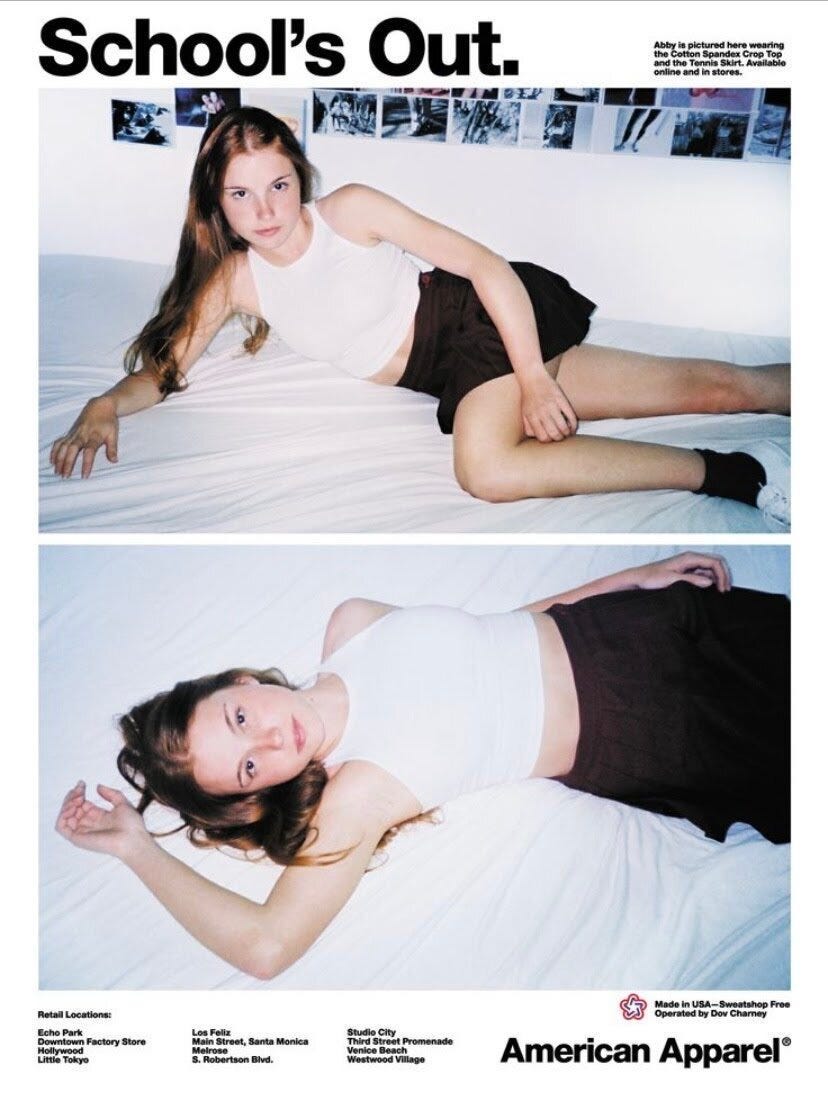
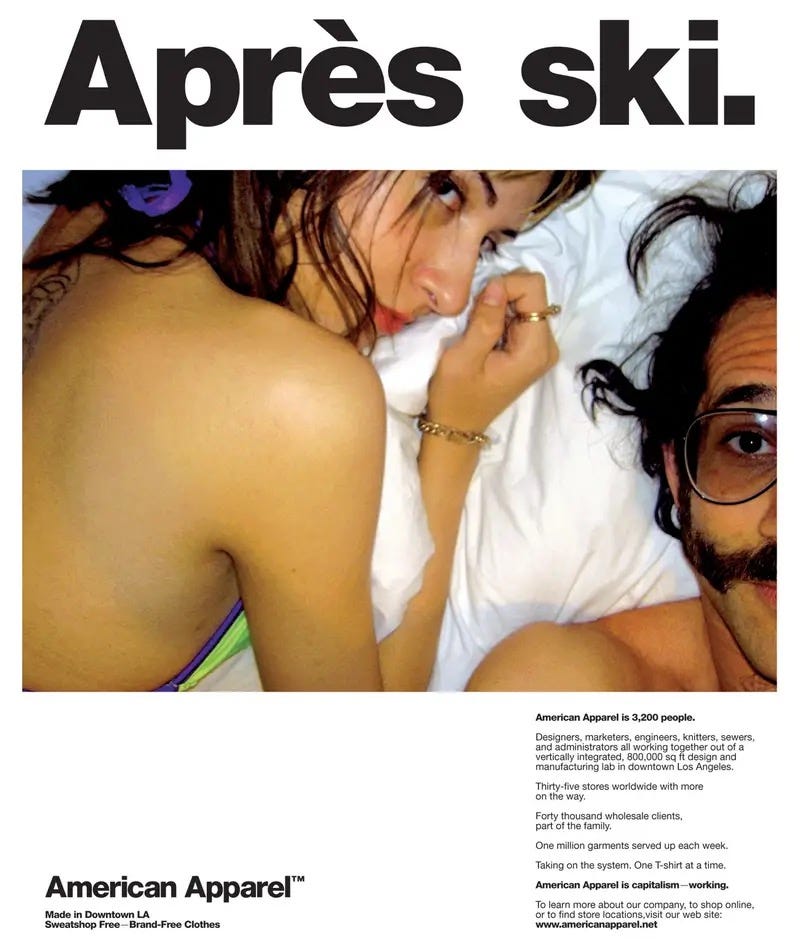
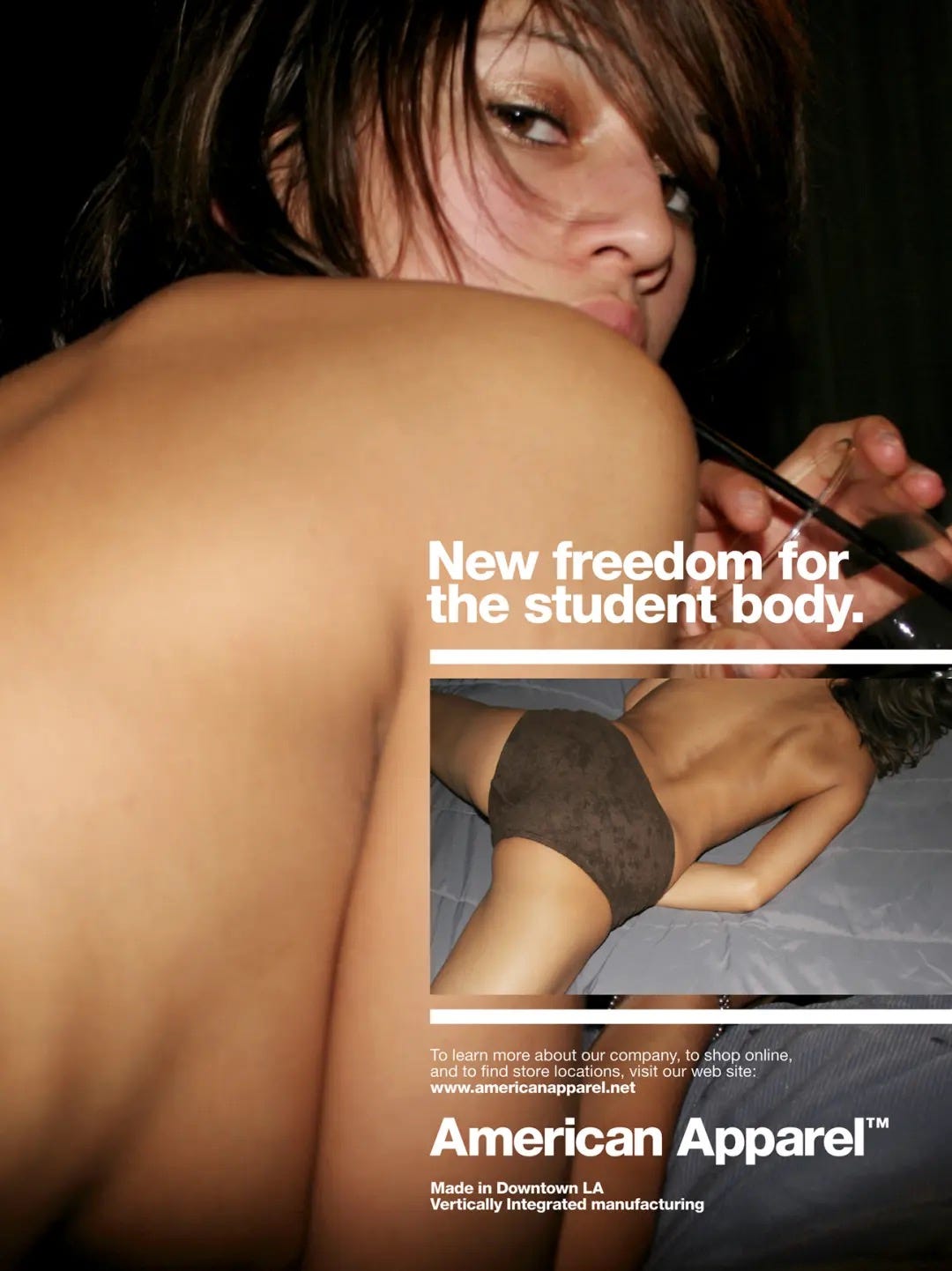

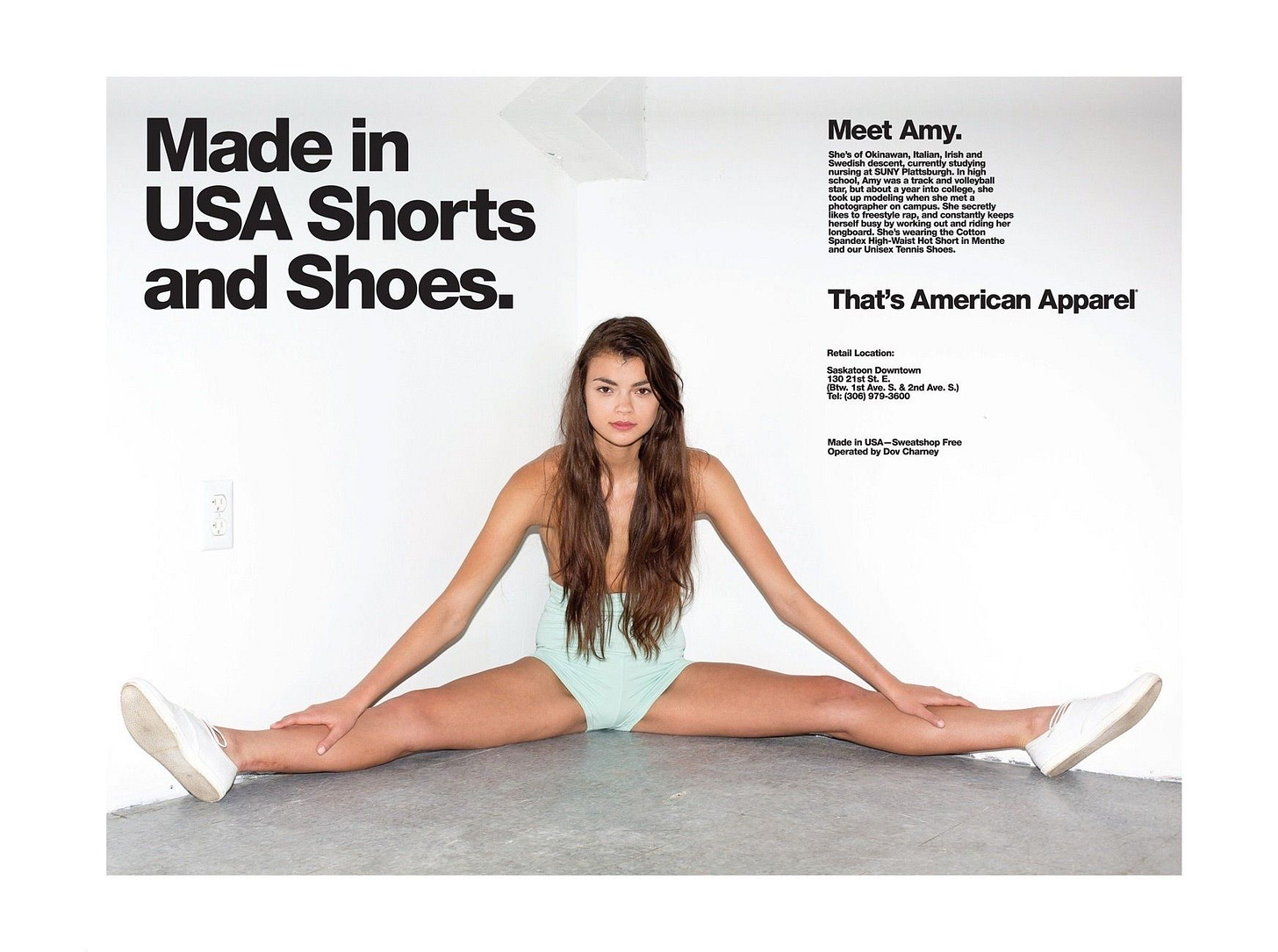
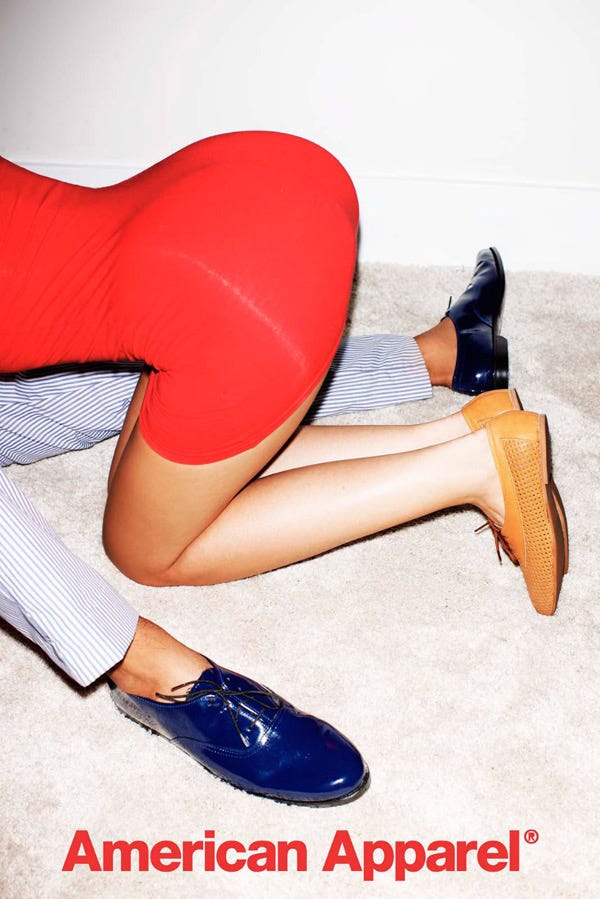
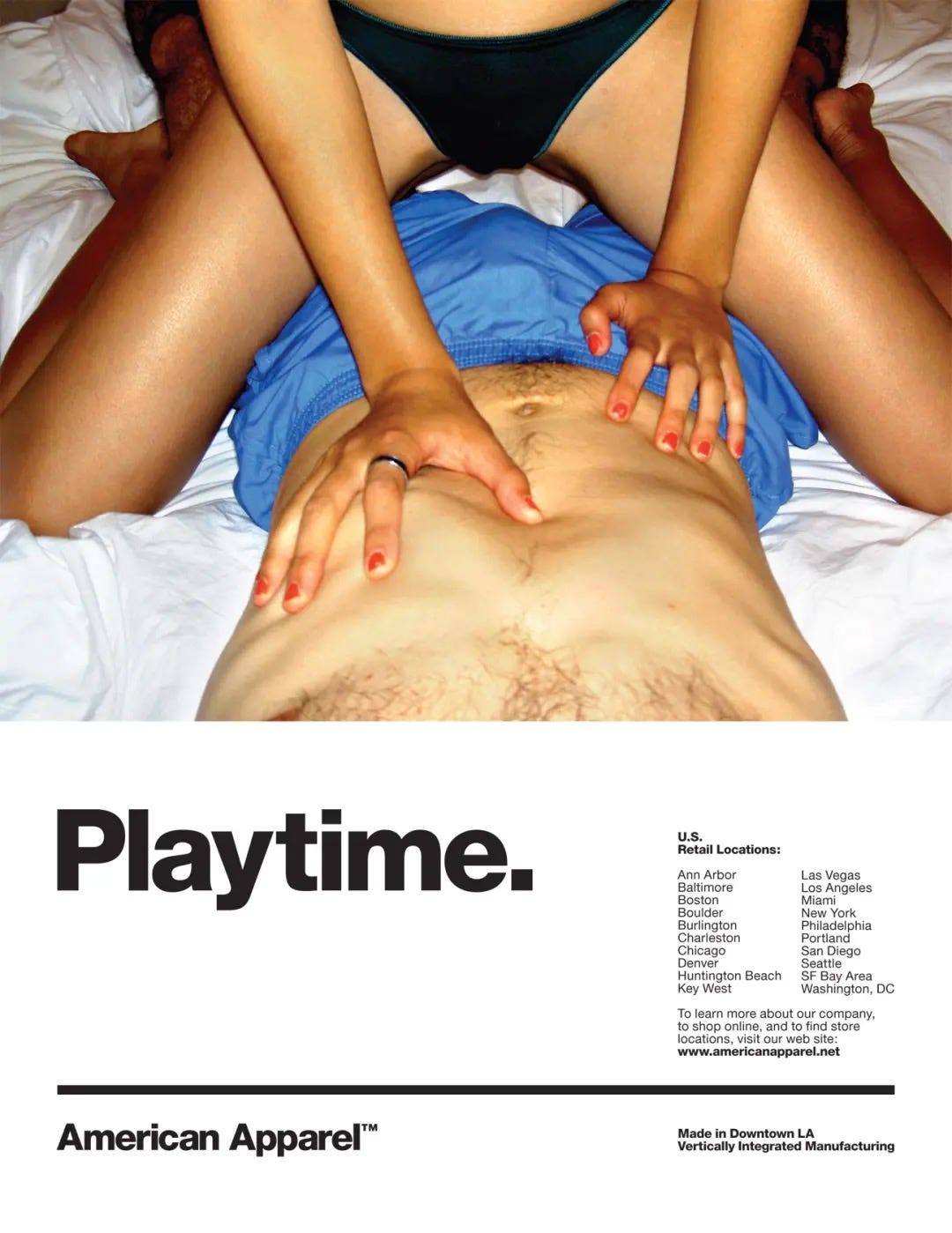
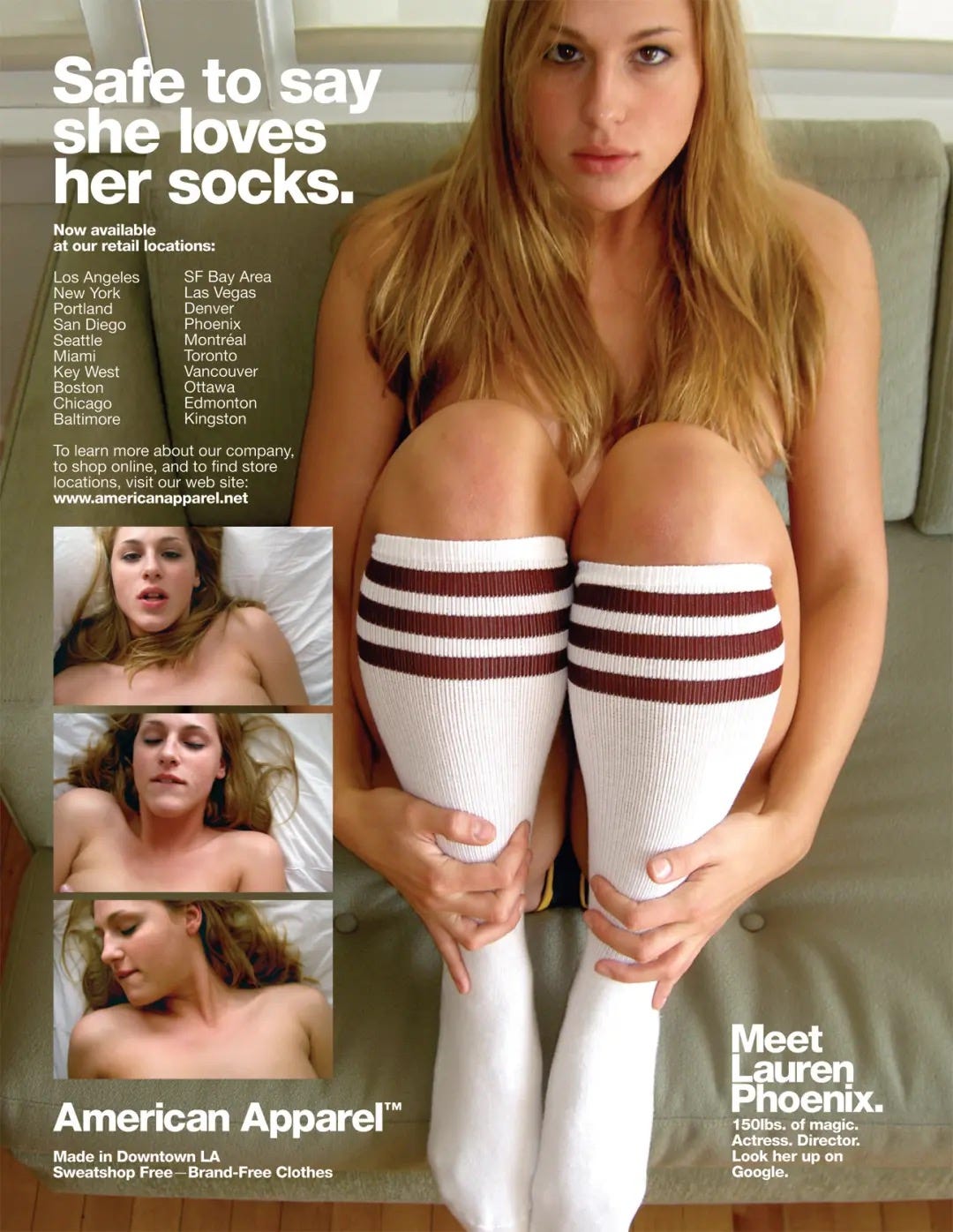
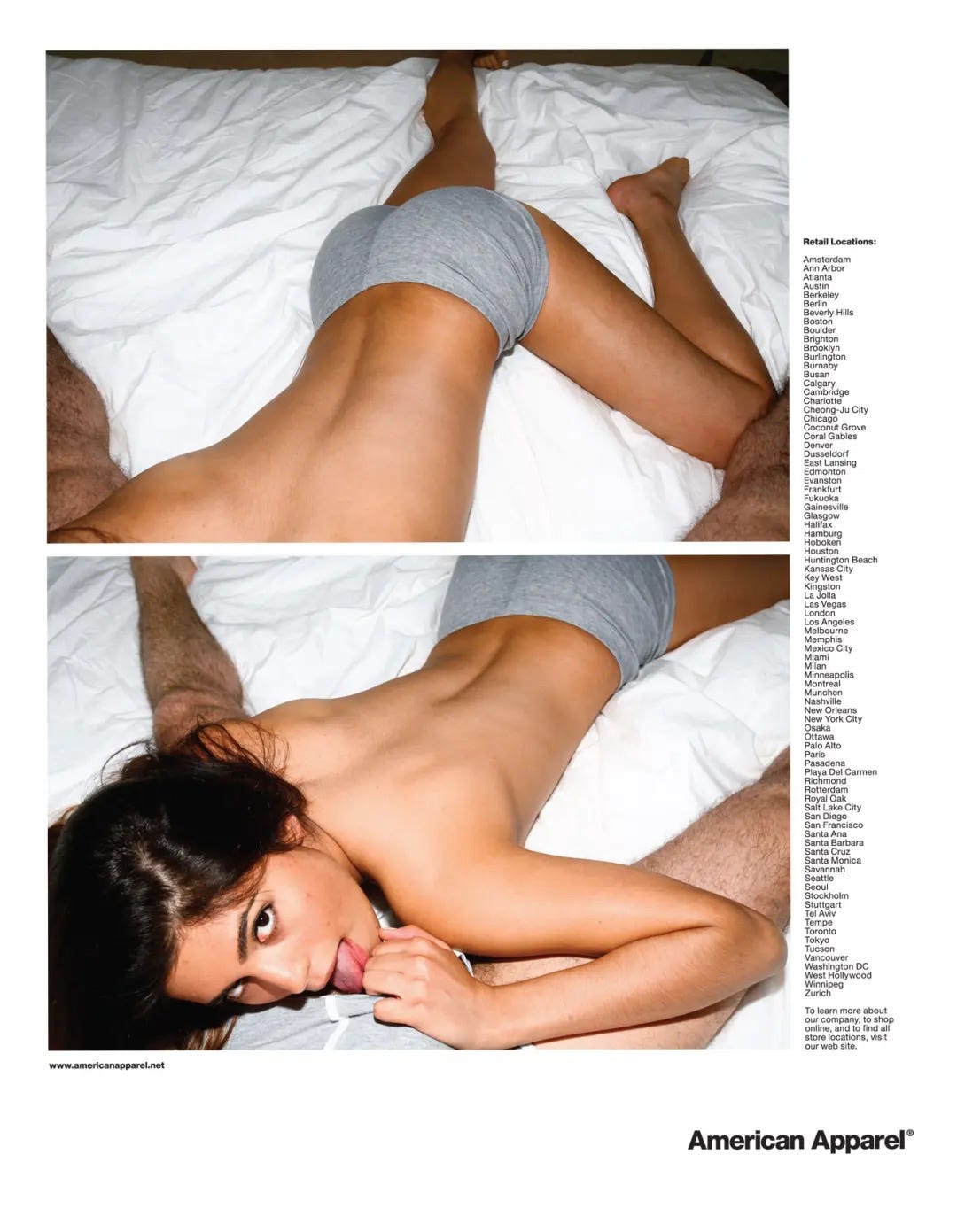
I grabbed this book as soon as I saw this post. I worked at a screen printing shop around this time and we were all obsessed with AA.
I never really cared about the brand all that much when it was "hot", but I pick up an AA shirt at the thrift store every so often for a couple of bucks. It's pretty quality stuff so I don't complain
Fun essay. We all went through crazy shit as teens and it's kind of funny to see trends and fads come and go.